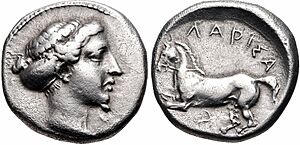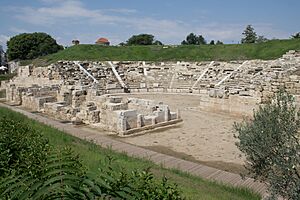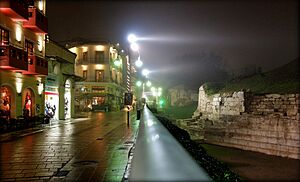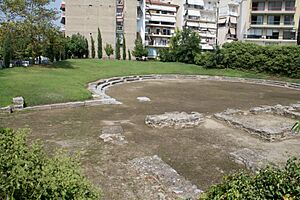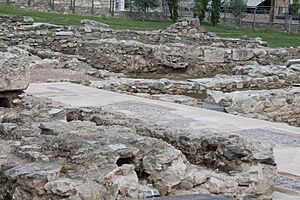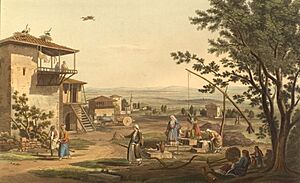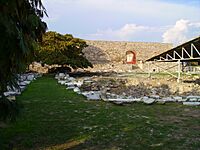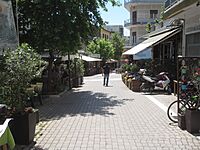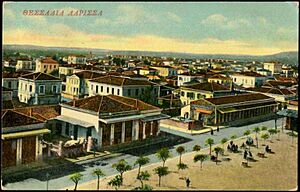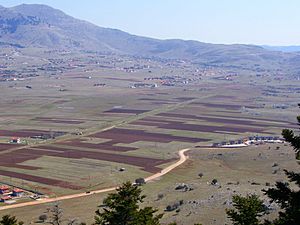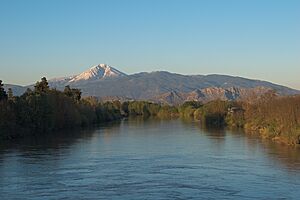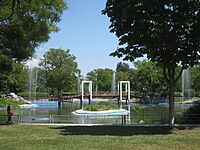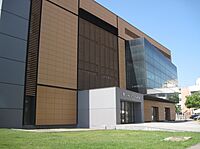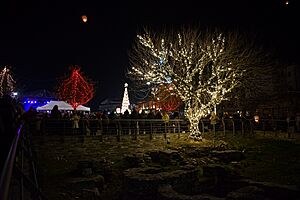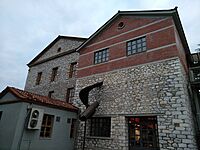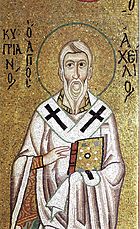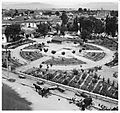Larissa facts for kids
Quick facts for kids
Larissa
Λάρισα (Greek)
|
||
|---|---|---|
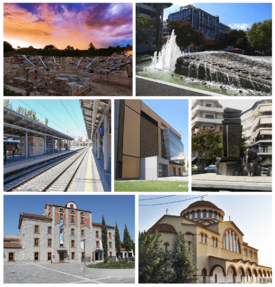 Clockwise from top: Central Square in downtown Larissa with the "Floating River" fountain, Municipal Theatre OUHL (Thessalian Theatre), Holocaust monument, Saint Achilles Cathedral, Old Mills of Pappas, Larissa railway station, and the First Ancient Theatre of Larissa.
|
||
|
||
| Country | Greece | |
| Administrative region | Thessaly | |
| Regional unit | Larissa | |
| Area | ||
| • Municipality | 335.98 km2 (129.72 sq mi) | |
| • Municipal unit | 122.59 km2 (47.33 sq mi) | |
| Elevation | 70 m (230 ft) | |
| Population
(2021)
|
||
| • Municipality | 164,095 | |
| • Municipality density | 488.407/km2 (1,264.968/sq mi) | |
| • Municipal unit | 148,562 | |
| • Municipal unit density | 1,211.86/km2 (3,138.70/sq mi) | |
| Demonym(s) | Larissean | |
| Time zone | UTC+2 (EET) | |
| • Summer (DST) | UTC+3 (EEST) | |
| Postal code |
41x xx
|
|
| Area code(s) | (+30)241 | |
| Website | www.larissa-dimos.gr | |
Larissa (/ləˈrɪsə/; Greek: Λάρισα, Lárisa, pronounced [ˈlarisa]) is a big city in Greece. It is the capital and largest city of the Thessaly region. Larissa is the fifth-most populated city in Greece. About 148,562 people lived there in 2021.
Larissa is also the capital of the Larissa regional area. It is a major center for farming and transportation. Roads and railways connect it to the port of Volos and the cities of Thessaloniki and Athens. The city of Larissa is located by the Pineios river. To the north and northeast, you can see Mount Olympus and Mount Kissavos.
Legend says that the famous hero Achilles was born here. Also, Hippocrates, known as the "Father of Medicine," died in Larissa. Today, Larissa is an important place for business, education, farming, and industry in Greece.
Contents
- Uncovering Larissa's Ancient Myths
- A Journey Through Larissa's Past
- Religious History of Larissa
- Exploring Larissa's Key Sights
- Larissa's Location and Climate
- How Larissa is Governed
- Larissa's Economy and Jobs
- Culture and Fun in Larissa
- Getting Around Larissa
- Sports in Larissa
- Larissa's Population Over Time
- Famous People from Larissa
- Sister Cities Around the World
- Images for kids
- See also
Uncovering Larissa's Ancient Myths
Stories of Heroes and Gods
According to Greek mythology, the city of Larissa was founded by Acrisius. He was accidentally killed by his grandson, Perseus, a famous hero. The great hero Peleus and his son Achilles were said to have lived here.
There is also a myth about a nymph named Larissa. She was believed to be the daughter of the very first human, Pelasgus.
The city of Larissa is even mentioned in the ancient Greek poem Iliad by Homer. It talks about "Pelasgian spearsmen" from fertile Larissa who fought alongside the Trojans. However, this Larissa might have been a different city. It was probably located in the Troad, across the Aegean Sea, not the Larissa where Achilles was born.
A Journey Through Larissa's Past
Ancient Times: From Fortresses to City-States
Early Settlements and the Name Larissa
People lived in the Larissa area even in the Paleolithic Age. The land around Larissa was very fertile. It was important for farming and was known for its horses in ancient times.
The name Larissa (Λάρισα Lárīsa) comes from an old word meaning "fortress." Many ancient Greek cities shared this name. The Larissa in Thessaly was first mentioned in connection with the powerful Aleuadai family. It was also a polis, which means a city-state.
Larissa in the Classical Era
Larissa was a busy city-state during the Classical Era. It is believed that the famous Greek doctor Hippocrates and the philosopher Gorgias of Leontini both died here.
Larissa started making its own coins in the late 400s BC. These coins showed the local spring nymph, Larissa, on one side. On the other side, they showed a horse, which was a symbol of Thessaly. Thessaly was known for its horses because it had wide plains.
Larissa was a very important city in ancient Thessaly. It was ruled by the Aleuadae family for many years. They were powerful leaders of the Thessalian army. Larissa had a democratic government. This is why it supported Athens during the Peloponnesian War.
Larissa Under Roman Rule
Larissa played a role in the Roman civil wars. After his defeat at the Battle of Pharsalus, Pompey sought safety in Larissa. In 196 BC, Larissa became an ally of Rome. It was also the main base for the Thessalian League.
Middle Ages: Changes and Challenges
Larissa was attacked by the Ostrogoths in the late 400s AD. It was rebuilt under the Byzantine emperor Justinian I. In the 700s, it became a major religious center.
In 986, Tsar Samuel of Bulgaria captured the city. He took the remains of its patron saint, Saint Achilleios. The city was later attacked by the Italo-Normans in 1082, but they did not succeed.
After the Fourth Crusade, Larissa was given to Lombard nobles. But it was soon taken back by Epirus.
Ottoman Period: A New Name and Culture
The Ottoman Empire took control of Larissa in 1423. Under Ottoman rule, the city was called Yeni-şehir i-Fenari, meaning "new citadel." Larissa became a city with mostly Muslim residents. It was the main town and military base for Ottoman Thessaly.
The city was known for its trade fairs in the 1600s and 1700s. Larissa remained part of the Ottoman Empire until 1881. Then, Thessaly became part of the independent Kingdom of Greece.
Modern Greek Era: Growth and Challenges
In 1881, Larissa joined the Kingdom of Greece. Many Turkish residents moved out of the city at this time. Greek authorities began to rebuild and expand the city.
During the Greco-Turkish War of 1897, Turkish troops briefly re-occupied Larissa. After a peace treaty, they left, and Larissa stayed part of Greece.
During World War II, the Jewish community in Larissa suffered greatly. Today, there is a Holocaust memorial and a synagogue in the city.
Larissa After World War II
After World War II, Larissa grew quickly. Today, it is the fourth-largest Greek city. It has many squares, restaurants, and cafes. Larissa has three public hospitals, including a military one. It is home to the Hellenic Air Force Headquarters and NATO Headquarters in Greece.
The city also has a School of Medicine and a School of Biochemistry – Biotechnology. It has the third-largest Institute of Technology in Greece. Larissa is known for having a lot of green spaces and many bars, taverns, and restaurants per person. It also has two public libraries and five museums.
Religious History of Larissa
Christianity came to Larissa early on. The first bishop was recorded in 325 AD. St. Achillius from the 300s is famous for his miracles. In the 700s, the city's religious authority was moved from the Pope of Rome to the Patriarchate of Constantinople.
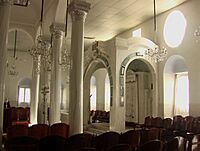
Larissa is an Orthodox Metropolis of the Church of Greece. For a short time in the 1200s, it was also a Latin archbishopric. Today, there is a Catholic church in the city.
Exploring Larissa's Key Sights
The old part of the city, from Frourio hill to the Central Square, holds many important landmarks. Here are some of the main sights:
- The Frourio Hill and the nearby First Ancient Greek Theatre.
- The Pineios river, which flows through the city center. You can find the St. Achillios church and Alkazar Park along its green banks.
- The First Ancient Greek Theatre of Larissa, built in the 3rd century BC.
- The Second Ancient Theatre, built in the 1st century BC.
- The ruins of the Basilica of St. Achillios. This early Byzantine church was dedicated to the city's patron saint.
- The church of St. Achillios Cathedral.
- The Bezesten of Larissa. This was an Ottoman market built in the 1400s.
- The Yeni Mosque, a rare 19th-century mosque now used as a museum.
- The Ottoman Baths, likely built in the 1400s.
- The monument to Hippocrates, the "Father of Medicine."
- The Diachronic Museum of Larissa, which shows the city's history from ancient times.
- Historic buildings like the Mill of Pappas and the Averofeios Agricultural School.
Larissa's Location and Climate
Larissa is about 120 kilometers (75 miles) southwest of Thessaloniki. It is also about 210 kilometers (130 miles) northwest of Athens.
Major highways like E75 and the main railway from Athens to Thessaloniki pass through Thessaly. The region is connected to the rest of Europe through the International Airport of Central Greece. This airport is near Larissa, about 60 kilometers (37 miles) away. Larissa is located on the Pineios river.
The city is close to many interesting places. These include Mount Olympus, Mount Kissavos, Meteora, Lake Plastira, and Pilio.
The Larissa Chasma, a large crack on Dione (one of Saturn's moons), is named after Larissa.
Larissa's Weather Patterns
Larissa has a cold semi-arid climate. This means it has dry summers and somewhat wetter winters. Winters are cold, and it can snow, but heavy snowfalls are rare. Summers are very hot, with temperatures often reaching or going above 40°C (104°F) for a few days each year. Thunderstorms can happen in summer and sometimes cause damage to farms. Larissa gets about 413 mm (16 inches) of rain each year. The average yearly temperature is 15.4°C (59.7°F).
| Climate data for Larissa, 1981–2010 normals | |||||||||||||
|---|---|---|---|---|---|---|---|---|---|---|---|---|---|
| Month | Jan | Feb | Mar | Apr | May | Jun | Jul | Aug | Sep | Oct | Nov | Dec | Year |
| Mean daily maximum °C (°F) | 10.2 (50.4) |
11.8 (53.2) |
15.4 (59.7) |
20.0 (68.0) |
26.0 (78.8) |
31.6 (88.9) |
33.4 (92.1) |
32.9 (91.2) |
28.6 (83.5) |
22.5 (72.5) |
15.3 (59.5) |
10.5 (50.9) |
21.6 (70.9) |
| Daily mean °C (°F) | 5.4 (41.7) |
6.4 (43.5) |
9.5 (49.1) |
13.5 (56.3) |
18.8 (65.8) |
23.9 (75.0) |
26.0 (78.8) |
25.5 (77.9) |
21.5 (70.7) |
16.5 (61.7) |
10.5 (50.9) |
6.4 (43.5) |
15.4 (59.7) |
| Mean daily minimum °C (°F) | 0.7 (33.3) |
1.1 (34.0) |
3.6 (38.5) |
6.9 (44.4) |
11.5 (52.7) |
16.1 (61.0) |
18.5 (65.3) |
18.1 (64.6) |
14.4 (57.9) |
10.5 (50.9) |
5.7 (42.3) |
2.2 (36.0) |
9.1 (48.4) |
| Average rainfall mm (inches) | 29.9 (1.18) |
33.5 (1.32) |
35.2 (1.39) |
39.5 (1.56) |
40.9 (1.61) |
19.8 (0.78) |
18.5 (0.73) |
19.6 (0.77) |
12.9 (0.51) |
44.2 (1.74) |
67.4 (2.65) |
51.2 (2.02) |
412.6 (16.26) |
| Average rainy days (≥ 1.0 mm) | 5 | 6 | 6 | 6 | 5 | 3 | 2 | 2 | 2 | 5 | 7 | 7 | 56 |
| Source: meteo-climat-bzh | |||||||||||||
| Climate data for Larissa, 1961–1990 normals (extremes 1955–2024) | |||||||||||||
|---|---|---|---|---|---|---|---|---|---|---|---|---|---|
| Month | Jan | Feb | Mar | Apr | May | Jun | Jul | Aug | Sep | Oct | Nov | Dec | Year |
| Record high °C (°F) | 22.8 (73.0) |
25.2 (77.4) |
34.8 (94.6) |
33.8 (92.8) |
40.0 (104.0) |
44.6 (112.3) |
45.5 (113.9) |
45.0 (113.0) |
41.9 (107.4) |
36.8 (98.2) |
29.6 (85.3) |
23.4 (74.1) |
45.5 (113.9) |
| Mean daily maximum °C (°F) | 9.6 (49.3) |
11.8 (53.2) |
14.9 (58.8) |
20.0 (68.0) |
25.7 (78.3) |
30.9 (87.6) |
33.0 (91.4) |
32.4 (90.3) |
28.7 (83.7) |
22.1 (71.8) |
16.0 (60.8) |
10.9 (51.6) |
21.3 (70.3) |
| Daily mean °C (°F) | 5.1 (41.2) |
6.8 (44.2) |
9.5 (49.1) |
14.0 (57.2) |
19.6 (67.3) |
24.9 (76.8) |
27.1 (80.8) |
26.0 (78.8) |
22.0 (71.6) |
16.1 (61.0) |
10.8 (51.4) |
6.3 (43.3) |
15.0 (59.0) |
| Mean daily minimum °C (°F) | 0.5 (32.9) |
1.5 (34.7) |
3.4 (38.1) |
6.3 (43.3) |
10.8 (51.4) |
15.0 (59.0) |
17.6 (63.7) |
17.1 (62.8) |
14.1 (57.4) |
9.8 (49.6) |
5.5 (41.9) |
1.8 (35.2) |
8.6 (47.5) |
| Record low °C (°F) | −21.6 (−6.9) |
−10.5 (13.1) |
−7.0 (19.4) |
−3.4 (25.9) |
1.4 (34.5) |
7.2 (45.0) |
11.0 (51.8) |
10.0 (50.0) |
5.0 (41.0) |
−2.0 (28.4) |
−6.4 (20.5) |
−17.5 (0.5) |
−21.6 (−6.9) |
| Average precipitation mm (inches) | 29.7 (1.17) |
34.9 (1.37) |
36.3 (1.43) |
28.9 (1.14) |
37.1 (1.46) |
23.5 (0.93) |
20.3 (0.80) |
15.5 (0.61) |
29.4 (1.16) |
47.1 (1.85) |
58.2 (2.29) |
52.3 (2.06) |
413.2 (16.27) |
| Average precipitation days (≥ 1.0 mm) | 5.8 | 5.8 | 5.8 | 5.0 | 5.3 | 3.5 | 2.0 | 1.7 | 2.8 | 5.5 | 6.5 | 6.9 | 56.6 |
| Average relative humidity (%) | 79.5 | 75.9 | 74.1 | 68.7 | 61.7 | 49.9 | 46.4 | 50.0 | 58.6 | 69.9 | 78.9 | 82.5 | 66.3 |
| Mean monthly sunshine hours | 104.7 | 117.8 | 157.5 | 213.8 | 266.3 | 307.2 | 337.1 | 320.1 | 247.6 | 171.8 | 126.0 | 101.0 | 2,470.9 |
| Source: NOAA | |||||||||||||
How Larissa is Governed
The city of Larissa is a municipality. In 2011, it joined with two other former municipalities, Giannouli and Koilada.
City Districts
The municipal unit of Larissa is divided into four city-districts. These include 29 city areas and two suburban communities. There is also the Community of Terpsithèa.
Mayors of Larissa
Larissa has had many mayors since it became part of Greece in 1881. The current mayor is Athanasios Mamakos, who started in 2024.
Larissa's Economy and Jobs
Larissa is a very important agricultural center in Greece. This is because it is located in the fertile plain of Thessaly.
In the manufacturing sector, Larissa is home to companies like Biokarpet, which makes carpets. It also has Orient Bikes, a bicycle company.
Larissa has a high number of bars, taverns, and restaurants compared to its population. Popular coffee chains like Mikel Coffee Company and Bruno Coffee Stores started here.
Culture and Fun in Larissa
Theatres and Performance Venues
Larissa has several places for arts and performances:
- Municipal Conservatory of Larissa
- Pappas's Mile Theatre
- Municipal Theatre OUHL of Larissa (Thessalian Theatre)
- Hatzigianeio Cultural Centre
- Tiritomba Shadows Theatre
Delicious Local Food
When you visit Larissa, you might want to try these local dishes:
- Batzina (Μπατζίνα): A special pie baked in the oven.
- Kelaidi (Κελαηδί)
- Pita (Πίτα): Traditional pies with thin pastry, baked in the oven. These include Kreatopita (meat pie), Loukanikopita (sausage pie), Melintzanopita (eggplant pie), Tyropita (cheese pie), and Spanakopita (spinach pie).
- Plastós (Πλαστός) pie
- Lahanópsomo (Λαχανόψωμο): Cabbage bread.
- Halvas (Χαλβάς): A sweet dessert.
Museums to Explore
Larissa has several museums where you can learn about its history and art:
- Diachronic Museum of Larissa / Archaeological and Byzantine Museum of Larissa
- Municipal Gallery of Larissa – G.I. Katsigras Museum
- Folklore and Historical Museum of Larissa
- Military Veterinary Museum of Larissa
- Museum of the Folklore Society of Larissa
- Museum of Grain and Flours
Festivals and Events
The city hosts exciting festivals, including:
- The "Pineiou Festival," which mainly features music.
- The "Mill of Performing Arts."
- "AgroThessaly," a big agricultural fair.
Getting Around Larissa
Larissa is in the middle of the Thessaly plain. It has good connections to major roads and railways.
- Larissa's Urban Bus System: For getting around the city.
- Larissa's Interurban System (Ktel Larissas): For travel to other towns.
- Larissa Central Railway Station: The main train station.
- Larissa National Airport: A military airport.
Sports in Larissa
Larissa has a popular football club called AEL FC. They play in the top Greek league. AEL FC won the Greek Championship in 1988 and the Greek Cup in 1985 and 2007. This makes them one of the most important football clubs in Greece.
Other professional football clubs in the city are Apollon and Iraklis.
AEL FC plays its home games at the AEL FC Arena. Other important sports places include the National Sport Center of Larissa (EAK Larissas). This center has the Alcazar Stadium and the Neapoli Indoor Hall. These venues host many sports like football, basketball, and swimming. They also hold cultural events.
| Club | Sports | Founded | Achievements |
|---|---|---|---|
| Apollon Larissa | Football | 1930 | Plays in Super League 2 |
| A.E.L. (Athletic Union of Larissa) | Football | 1964 | Won Greek Championship and Greek Cup |
| Basketball | 2006 | Used to play in the Greek Basket League | |
| EA Larissa | Volleyball | 1968 | Used to play in the Greek Volleyball League |
| Iraklis Larissa | Football | 1930/1982 (refoundation) | Plays in Super League 2 |
| Olympia Larissa | Basketball | 1979 | Used to play in the Greek Basket League |
| Larisa | Basketball | 1984 | Plays in the Greek Basket League |
| Gymnastikos S. Larissas | Basketball | 1928 | Used to play in the Greek Basket League |
| Filathlitikos Larissaikos Syllogos | Volleyball | 1990 | Used to play in the Greek Women's Volleyball League |
Larissa's Population Over Time
The number of people living in Larissa has changed a lot over the years:
| Year | Municipal Unit | Municipality |
|---|---|---|
| 1940 | 32,686 | 35344 |
| 1951 | 41,016 | - |
| 1961 | 56,010 | - |
| 1971 | 72,336 | - |
| 1981 | 102,426 | - |
| 1991 | 113,090 | 129,429 |
| 2001 | 131,095 | 145,981 |
| 2011 | 146,926 | 162,591 |
| 2021 | 148,562 | 164,095 |
Famous People from Larissa

Many notable people have come from Larissa throughout history:
Ancient Times
- Achilles (mythology): A legendary Greek hero.
- Gorgias of Leontinoi (483 BC–375 BC): A famous philosopher who worked and died in Larissa.
- Hippocrates of Kos (460 BC–370 BC): The "Father of Medicine," who worked and died in Larissa.
- Achillius of Larissa (270–330): The first bishop and patron saint of the city.
Modern Times
- Giorgakis Olympios (1772–1821): A commander during the Greek War of Independence.
- Theoklitos Farmakidis (1784–1860): A scholar who played a role in the Modern Greek Enlightenment.
- M. Karagatsis (1908–1960): A well-known novelist and journalist.
- Sofia Vembo (1910–1978): A famous singer and actress.
- Lakis Lazopoulos (1956–): An actor, comedian, and director.
- Thanasis Papakonstantinou (1959–): A poet, songwriter, and musician.
- Vassilis Spanoulis (1982–): A very famous basketball player.
- Fani Halkia (1979–): An Olympic hurdler.
Sister Cities Around the World
Larissa has "twin towns" or "sister cities" in different countries. This means they have special friendly relationships:
Images for kids
-
A bust of Koumoundouros in central square
See also
 In Spanish: Larisa para niños
In Spanish: Larisa para niños




